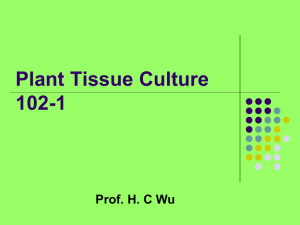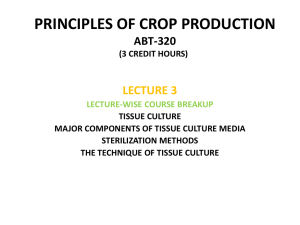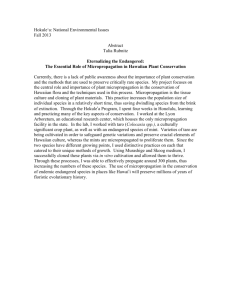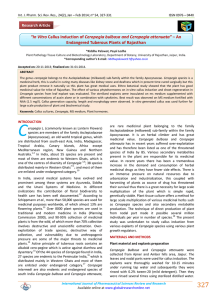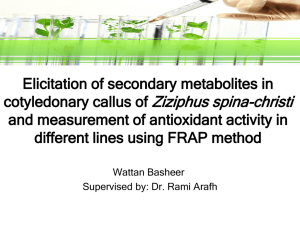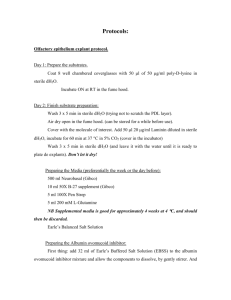Document 13309355
advertisement
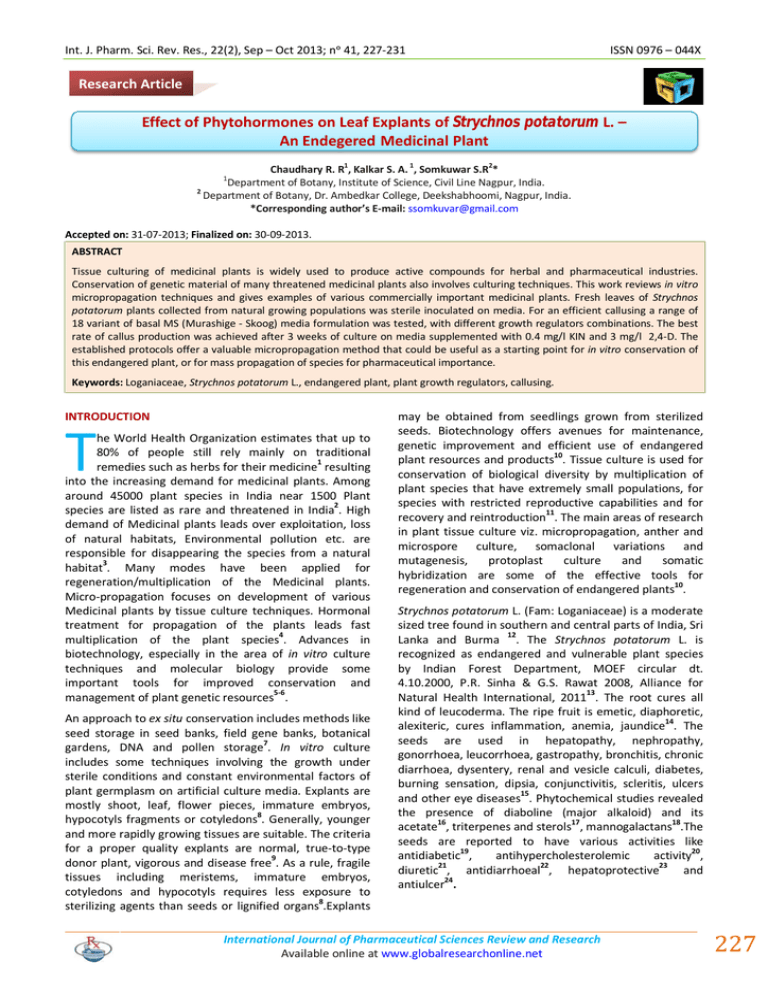
Int. J. Pharm. Sci. Rev. Res., 22(2), Sep – Oct 2013; nᵒ 41, 227-231 ISSN 0976 – 044X Research Article Effect of Phytohormones on Leaf Explants of Strychnos potatorum L. – An Endegered Medicinal Plant 1 1 2 Chaudhary R. R , Kalkar S. A. , Somkuwar S.R * Department of Botany, Institute of Science, Civil Line Nagpur, India. 2 Department of Botany, Dr. Ambedkar College, Deekshabhoomi, Nagpur, India. *Corresponding author’s E-mail: ssomkuvar@gmail.com 1 Accepted on: 31-07-2013; Finalized on: 30-09-2013. ABSTRACT Tissue culturing of medicinal plants is widely used to produce active compounds for herbal and pharmaceutical industries. Conservation of genetic material of many threatened medicinal plants also involves culturing techniques. This work reviews in vitro micropropagation techniques and gives examples of various commercially important medicinal plants. Fresh leaves of Strychnos potatorum plants collected from natural growing populations was sterile inoculated on media. For an efficient callusing a range of 18 variant of basal MS (Murashige - Skoog) media formulation was tested, with different growth regulators combinations. The best rate of callus production was achieved after 3 weeks of culture on media supplemented with 0.4 mg/l KIN and 3 mg/l 2,4-D. The established protocols offer a valuable micropropagation method that could be useful as a starting point for in vitro conservation of this endangered plant, or for mass propagation of species for pharmaceutical importance. Keywords: Loganiaceae, Strychnos potatorum L., endangered plant, plant growth regulators, callusing. INTRODUCTION T he World Health Organization estimates that up to 80% of people still rely mainly on traditional remedies such as herbs for their medicine1 resulting into the increasing demand for medicinal plants. Among around 45000 plant species in India near 1500 Plant species are listed as rare and threatened in India2. High demand of Medicinal plants leads over exploitation, loss of natural habitats, Environmental pollution etc. are responsible for disappearing the species from a natural habitat3. Many modes have been applied for regeneration/multiplication of the Medicinal plants. Micro-propagation focuses on development of various Medicinal plants by tissue culture techniques. Hormonal treatment for propagation of the plants leads fast multiplication of the plant species4. Advances in biotechnology, especially in the area of in vitro culture techniques and molecular biology provide some important tools for improved conservation and management of plant genetic resources5-6. An approach to ex situ conservation includes methods like seed storage in seed banks, field gene banks, botanical gardens, DNA and pollen storage7. In vitro culture includes some techniques involving the growth under sterile conditions and constant environmental factors of plant germplasm on artificial culture media. Explants are mostly shoot, leaf, flower pieces, immature embryos, hypocotyls fragments or cotyledons8. Generally, younger and more rapidly growing tissues are suitable. The criteria for a proper quality explants are normal, true-to-type donor plant, vigorous and disease free9. As a rule, fragile tissues including meristems, immature embryos, cotyledons and hypocotyls requires less exposure to 8 sterilizing agents than seeds or lignified organs .Explants may be obtained from seedlings grown from sterilized seeds. Biotechnology offers avenues for maintenance, genetic improvement and efficient use of endangered plant resources and products10. Tissue culture is used for conservation of biological diversity by multiplication of plant species that have extremely small populations, for species with restricted reproductive capabilities and for recovery and reintroduction11. The main areas of research in plant tissue culture viz. micropropagation, anther and microspore culture, somaclonal variations and mutagenesis, protoplast culture and somatic hybridization are some of the effective tools for regeneration and conservation of endangered plants10. Strychnos potatorum L. (Fam: Loganiaceae) is a moderate sized tree found in southern and central parts of India, Sri Lanka and Burma 12. The Strychnos potatorum L. is recognized as endangered and vulnerable plant species by Indian Forest Department, MOEF circular dt. 4.10.2000, P.R. Sinha & G.S. Rawat 2008, Alliance for Natural Health International, 201113. The root cures all kind of leucoderma. The ripe fruit is emetic, diaphoretic, alexiteric, cures inflammation, anemia, jaundice14. The seeds are used in hepatopathy, nephropathy, gonorrhoea, leucorrhoea, gastropathy, bronchitis, chronic diarrhoea, dysentery, renal and vesicle calculi, diabetes, burning sensation, dipsia, conjunctivitis, scleritis, ulcers and other eye diseases15. Phytochemical studies revealed the presence of diaboline (major alkaloid) and its acetate16, triterpenes and sterols17, mannogalactans18.The seeds are reported to have various activities like antidiabetic19, antihypercholesterolemic activity20, 21 22 diuretic , antidiarrhoeal , hepatoprotective23 and 24 antiulcer . International Journal of Pharmaceutical Sciences Review and Research Available online at www.globalresearchonline.net 227 Int. J. Pharm. Sci. Rev. Res., 22(2), Sep – Oct 2013; nᵒ 41, 227-231 ISSN 0976 – 044X 31, 41 MATERIALS AND METHODS Tissue culture techniques There are many types of tissue culture techniques available for micropropagation and plant regeneration. Some commonly used are listed in this section: Sterilization of explants The Strychnos potatorum L. plants were grown at the Botanical garden of, Institute of Science, Civil Lines, Nagpur, India. The young fresh leaf explants collected from Strychnos potatorum L. plant were washed under running tap water for 30 minutes and was carried out surface sterilization according to our previously published 25 report . The sterilized explants were then excised into small pieces and then inoculated into flask and bottle containing 60 ml basal MS (Murashige - Skoog)26 medium, and sealed under asceptic condition. Cultured flask and bottle were maintained at 22°C with a 14 hr photoperiod (3000 lux). Explant source Explant is material used as initial source of tissue culture. Tissue culture success mainly depends on the age, types and position of explants 27 because not all plant cells have the same ability to express totipotency 28-30. The most commonly used explants are shoot tips, nodal buds and root tips. Large explants can increase chances of contamination and small explants like meristems can sometimes show less growth 30-31. Sterilization Microbial contamination of plant tissue culture is a common problem 31-33. Common bacterial contaminants are Bacillus, Pseudomonas, Staphylococcus and Lactobacillus 33-35. Preventing of microbial contamination of plant tissue cultures through sterilization is crucial to successful micropropagation of plant. The identification of common contaminants of the explants may proved to be effective means for preventing contamination by adding small quantity of fungal and / or bacterial specific antibiotics in the cultures media36. Microbes multiply and compete with growing explant for nutrients, while releasing chemicals which can alter culture environments 30-33 e.g. pH and inhibit explants growth or cause death . Explants are cleaned by distilled water and sterilized using 2% bovistin, 0.1%Sodium hypochlorite, and ethyl alcohol32, 37-38. Sterilization of laboratory instruments is carried out by autoclaving, alcohol washing, baking, radiations, flaming and fumigation 39. A considerable decrease in bacterial contamination was seen by using ultrasonic sonicator40. Tissue culture Media Culture media contains vital nutrients and elements for in vitro growth of plant tissues. Choosing the right media composition is important for successful tissue 27,41-42 culturing . Medium contains a carbon source (sucrose), macro and micro nutrients, vitamins, hormones and other organic substances . A wide range of media are available for plant tissue culture, but MS29 medium is commonly used27, 29, 41. Other media used are Linsmaier43 44 Skoog (LS) , Schenk and Hilderbrandt (SH) , WPM 45 (Woody plant medium) , and the Nitsch and Nitsch (NN)47. Agar is not essential media component but is used as gelling agent 39, 41. It prevents death of cultured cells due to submerging and lack of oxygen in liquid medium. The pH of culture media is normally between 5.0-6.0, and 41 is also very important as it affects uptake of ions . Plant growth hormones Growth hormones regulate various physiological and morphological processes in plants and are also known as plant growth regulators (PGRs) or phytohormones 41, 47. PGRs are synthesized by plants; therefore many plant species can grow successfully without external medium supplements48-50. Hormones can also be added into cultures to improve plant growth and to enhance metabolite synthesis 39, 41. As observed in S. potatorum, in vitro callusing was not achieved without adequate concentrations exogenous hormones. Culture Browning Explants in cultures release phenol compounds, which are oxidised by enzymes known as polyphenol oxidase, and cause the media to turn brown 32, 51. Browning can be minimized by adding antioxidants or phenol absorbents for e.g. ascorbic acid, glutathione, activated charcoal and polyvinylpyrrolidone 38 or by transferring explants into new culture media on regular intervals 32, 52. Callus Induction Callus is an undifferentiated mass of tissue which appears on explants within a few weeks of transfer onto growth medium with suitable hormones41. Callus formation occurs from revered process of cell differentiation, known as dedifferentiation or redifferentiation31. Different growth hormones are used to promote callus induction and development. New plants can be successfully regenerated from callus through organogenesis53. The 18 variant of basal MS media were tested to stimulate callusing (with 1/10 auxin/cytokinin ratio). Callus induced from leaf explants. Callus cultures were multiplied and maintained by subculturing onto MS medium using 0.4 mg/l KIN and 3 mg/l 2,4-D at three week intervals. RESULTS AND DISCUSSION In the present study, we have tried different growth media for the maximum induction of calli. It includes Murashige and Skoog, Gamborg’s B5, and White’s media having different hormonal combinations of auxins (2,4-D, NAA, IAA and IBA) and cytokinins, (Kinetin, 6-BAP and BAP). Murashige and Skoog’s medium was found to be suitable for the induction of calli while all other media showed no response. A simple and effective protocol was developed for the in vitro callusing for micropropagation of S. potatorum. We investigated the effect of different auxins and cytokinins International Journal of Pharmaceutical Sciences Review and Research Available online at www.globalresearchonline.net 228 Int. J. Pharm. Sci. Rev. Res., 22(2), Sep – Oct 2013; nᵒ 41, 227-231 on the efficiency of callusing. Callus development from leaf explants was unsuccessful for most of the cytokinin treatments. The combination of cytokinin Kinetin (KIN), at the lower concentration (0.4 mg/L) and auxins 2,4Dichlorophenoxyacetic acid (2,4-D), at (3 mg/L) produced the callus from leaf explants, and resulted in the maximum growth at this concentration. During the initial stage (up to 2 weeks of incubation), callus growth was initiated from the base of some explants and expansion and proliferation of cells at the cut surface were observed. ISSN 0976 – 044X 55 and Van Staden observed that MS basal medium with only 2,4-D showed the callus formation Gloriosa and Sandersonia plant. Jadhav and Hegde56 also reported that the callus formation from Gloriosa occurs at 2,4-D (18.08µM) + Kn 23.20µM + CH (10 mg/l)+ CW (20%). On the contrary, in the present study, we have reviewed many research articles on the S. potatorum but yet there is no report of callusing from any explants for micropropagation. This is the first hand report of its own kind. There is no such work type of research has been carried out. In Cephaelis ipecacuanha 2, 4-D and NAA along with 54 kinetin promoted callus induction and growth . Finnie Plate-1: A- S.potatorum twig B-Explant, B-Callus Initiation, C- Callus CONCLUSION This is the first report describing callus induction protocol for micro-propagating S. potatorum using leaf explants. MS medium supplemented with 0.4 mg l-1 KIN and 3.0 mg l-1 2,4-D is the most effective medium for callus induction. This protocol could be utilized for conservation and clonal propagation as well as chemical analysis of this medicinally important endangered plant. This protocol can be exploited for conservation and commercial propagation of this plant in the Indian subcontinent and may be useful for genetic improvement programs. The prime importance of in vitro propagation of rare, endangered and vulnerable plants would be to generate a large number of planting materials from a single explant without destroying the mother plant and subsequently their restoration in the natural habitat, thus conserving the biodiversity. No any reports were found in literature regarding the in vitro callus production from S. potatorum plant. Although the plant is under threatened and endangered category, it must require a standard method for conservation and high yield of similar secondary metabolites as in the natural plant. Above all in view and consideration the current work was undertaken to produce a standard procedure for the in vitro induction of callus. Advances in plant tissue culture will enable rapid multiplication and sustainable use of medicinal plants for future generations. Acknowledgement: We thank Director, Institute of Science, Civil Lines, Nagpur, India for the research facilities and for permission to use Plant Tissue Culture Laboratories for research. REFERENCES 1. Kala, C.P., Indigenous uses, population density and conservation of threatened medicinal plants in protected areas of the Indian Himalayas. Conservation Biology 19, 2005, 368-378. 2. Myers N. Threatened biotas: ‘hotspots’ in tropical forests. Environmentalist 8, 1988, 187-208. 3. Yadav SR, Mayur Y. K., Threatened Ceropegias of the Western Ghats and Strategies for their Conservation. In: International Journal of Pharmaceutical Sciences Review and Research Available online at www.globalresearchonline.net 229 Int. J. Pharm. Sci. Rev. Res., 22(2), Sep – Oct 2013; nᵒ 41, 227-231 Rawat GS (Ed.), Special Habitats and Threatened Plants of India. ENVIS Bulletin: Wildlife and Protected Areas, Wildlife Institute of India, Dehradun, India 11(1) 2008, 239. ISSN 0976 – 044X mannogalactan from Strychnos potatorum, Ind J Pharm Sci, 53, 1991, 53-57. 4. Constabel, F, Medicinal plant biotechnology. Planta Med. 56, 1990, 421–425. 21. Biswas S, Murugesan T, Maiti K, Ghosh L, Study on the diuretic activity of Strychnos potatorum Linn, seed extract in albino rats. Phytomed, 8, 2001, 469-471. 5. Ramanatha Rao V, Riley R, The use of biotechnology for conservation and utilization of plant genetic resources. Plant Genet Resour Newsl 97, 1994, 3-20. 22. Swathi B, Murugesan T, Sanghamitra Sinha, Antidiarrhoeal activity of Strychnos potatorum seed extract in rats. Fitoterapia, 73, 2002, 43-47. 6. Withers L. A , Collecting in vitro for genetic resources conservation. In: Guarino L, Ramanatha Rao V, Reid R (eds) Collecting plant germplasm diversity, Technical Guideline, CABI, Wallingford, UK, 1995, 51-526. 23. Sanmuga priya E, Venkataraman S, Studies on hepatoprotective and antioxidant actions of Strychnos potatorum Linn seeds on CCl4 induced acute hepatic injury in experimental rats. J Ethnopharmacol, 05, 2006, 154-160. 7. Rao N.K, Plant genetic resources: Advancing conservation and use through biotechnology. African J Biotech 3 (2), 2004, 136-145. 8. Paunesca A., Biotechnology for endangered plant conservation: A critical overview. Romanian Biotech Letters 14 (1), 2009, 4095-4104. 24. Sanmuga priya E, Venkataraman S, Antiulcerogenic potential of Strychnos potatorum Linn seeds in aspirin+pylorus ligation induced ulcers in experimental rats. Phytomed, 14, 2007, 360-365. 9. Fay, M.F., Conservation of rare and endangered plants using in vitro methods, In Vitro Cellular and Developmental Biology – Plant, 28, 1992, 1–4. 10. Bapat, V.A., Yadav, S.R., Dixit, G.B., Rescue of endangered plants through biotechnological applications. Natl. Acad. Sci. Lett. 31, 2008, 201-210. 11. Bramwell, D, The role of in vitro cultivation in the conservation of endangered species. In: Hernández, B.J.E., Clemente, M., Heywood, V. (Eds.) Proc. Int. Congress of Conserv. Techniques in Botanic Gardens, Koeltz Scientific Books. 1990, 3-15. 12. Kirtikar KR, Basu BD, Indian medicinal plants. In Allahabad Edited by: Basu LM, 3, 1933. 13. Kagithoju S., Godishala V. , Kairamkonda M., Kurra H., and Nanna R. S., Recent Advances in Elucidating the Biological and Chemical Properties of Strychnos potatorum L.- A Review Int J Pharm Bio Sci, 3(4):(B), 2012, 291 – 303 14. Kirtikar KR, Basu BD, Illustrated Indian Medicinal Plants.Edited by: Mhaskar KS, Blatter, 2000. 15. Asima C, Satyesh CP, The Treatise on Indian Medicinal Plants. Publications and Information Directorate, CSIR, 4, 2001, 85-87. 16. Harkishan Singh, Kapoor KVijay, Phillipson JD, Bisset NG, Diaboline from Strychnos potatorum. Phytochem, 14,1975, 587-588. 17. Harkishan Singh, Kapoor K. Vijay, Investigation of Strychnos Spp.III Study of triterpenes and sterols of Strychnos potatorum seeds. Planta Med, 28, 1975, 392-396. 18. Adinolfi M, Corsaro MM, Lanzetta R, Parilli M, Folkard G, Grant W, Sutherland J, Composition of the coagulant polysaccharide fraction from Strychnos potatorum, Carbohydrate Res, 263,1994, 103-110. 19. Mathuram LN, Samanna HC, Ramasamy VM, Natarajan R, Studies on the hypoglycemic effects of Strychnos potatorum and Acacia arabica on alloxan diabetes in rabbits. Cheiron, 10, 1981,1-5. 20. Venkata Rao E, Ramana KS, Venkateswarao M, Revised structure and antihypercholesterolemic activity of a 25. Rosli N, Maziah M, Chan KL,Sreeramanan S, Factors affecting the accumulation of 9-methoxycanthin-6-one in callus cultures of Eurycoma longifolia, Journal of Forestry Research 20, 2009, 54-58. 26. Murashige, T., Skoog, F., A revised medium for rapid growth and bioassays with tobacco tissue cultures. Physiologia Plantarum, 15,1962, 472- 497. 27. Gamborg, O.L., T. Murashige, T.A. Thorpe and I.K. Vasil, Plant-tissue culture media. Journal of the Tissue Culture Association, 12, 1976, 473-478. 28. Sasikumar, S., S. Raveendar, A. Premkumar, S. Ignacimuthu, P. Agastian, Micropropagation of Baliospermum montanum (Willd.) Muell. Ara.-A threatened medicinal plant. Indian Journal of Biotechnology, 8, 2009, 223-226. 29. Murashige, T. and F. Skoog, A revised medium for rapid growth and bioassays with tobacco tissue cultures. Physiol Plant, 15, 1962, 473-497. 30. Staba, E.J. and J.E.A. Seabrook, Laboratory Culture. Plant Tissue Culture As a Source of Biochemicals, CRC Press, Boca Raton, 1980, 1-20. 31. Fowler, M.R., F.W. Rayns and C.F. Hunter (Editor), The language and aims of plant cell and tissue culture. In Vitro Cultivation of Plant Cells, Butterworth-Heinemann Ltd, Oxford, 1993, 1-18. 32. Rout G.R., S. Samantaray, and P. Das, In vitro manipulation and propagation of medicinal plants. Biotechnology Advances, 18, 2000, 91-120. 33. Leifert, C. and W.M. Waites, Bacterial growth in Plant tissue culture media. Journal of Applied Bacteriology, 72, 1992, 460-466. 34. Leifert, C., W.M. Waites, and J.R. Nicholas, Bacterial contaminants of micropropagated plant cultures. Journal of Applied Microbiology, 67, 1989, 353-361. 35. Leifert, C., J.Y. Ritchie, and W.M. Waites, Contaminants of Plant tissue and Cell cultures. World Journal of Microbiology & Biotechnology, 7, 1991,452-469. 36. Somkuwar S.R., Kalkar S. A., Bodele S. K., and Chaudhary R. R, Microbial contamination in Andrographis paniculata and Strychnos potatorum leaf cultures. Multilogic in Science 2, (4), 2013. International Journal of Pharmaceutical Sciences Review and Research Available online at www.globalresearchonline.net 230 Int. J. Pharm. Sci. Rev. Res., 22(2), Sep – Oct 2013; nᵒ 41, 227-231 ISSN 0976 – 044X 37. Prakash, S. and J. Van Staden, Micropropagation of Hoslundia opposita Vahl--a valuable medicinal plant. South African Journal of Botany, 73, 2007, 60-63. 47. Srivastava, L.M., Plant Growth and Development: Hormones and Environment Academic Press, New York, 2002, 140-143. 38. Matkowski, A, Plant in vitro culture for the production of antioxidants - A review. Biotechnology Advances, 26, 2000, 548-560. 48. Bhavisha, B.W. and Y.T. Jasrai, Micropropagation of an Endangered Medicinal Plant: Curculigo orchioides Gaertn. Plant tissue Culture, 13, 2003, 13-19. 39. Rayns, F.W., M.R. Fowler amd C.F. Hunter, Media design and use. In Vitro Cultivation of Plant Cells, ButterworthHeinemann Ltd. Oxford, 1993, 43-64. 49. Hussey G, In vitro propagation of monocotyledonous bulbs and corms. Plant Cell, Tissue and Organ Culture, 19, 1982, 677-680. 40. Garro-Monge, G., A.M. Gatica-Arias, and Valdez-Melara, Somatic embryogenesis, Plant regeneration and Acemannan detection in Aloe (Aloe barbadensis MILL.). Agronomia Costarricense, 32, 2008, 41-52. 50. Baksha, R., M.A.A. Jahan, R. Khatum and J.L. Munshi, Micropropagation of Aloe barbadensis Mill. through In vitro Culture of Shoot tip Explants. Plant tissue Culture and Biotechnology. 15, 2005, 121-126. 41. Bhojwani, S.S. and M.K. Razdan, Plant tissue culture: Theory and Practice: Developments in crop science Elsevier, Amsterdam 5, 1996. 51. Bhat, S.R. and K.P.S. Chandel, A novel technique to overcome browning in tissue culture. Plant Cell Reports, 10, 1991, 358-361. 42. Huang, L. and T. Murashige, Plant tissue culture media: major constituents; their preparation and some applications. Tissue Culture Assoc, 3, 1977, 539-548. 52. Krishnan, P.N. and S. Seeni, Rapid Micropropagation of Woodfordia fruticosa (L) Kurz (Lythraceae), A rare medicinal plant. Plant Cell Reports, 14, 1994, 55-58. 43. Linsmaier, E.M. and F. Skoog, Organic growth factor requirement of tobacco tissue cultures. Physiol. Plant, 18, 1965, 100-127. 53. Sears, R.G. and E.L. Deckard, Tissue cultire variability in wheat- callus induction and plant regeneration. Crop Science, 22, 1982, 546-550. 44. Schenk, R.V. and A.C. Hilderbrandt, Medium and techniques for induction and growth of monocotyledonous dicotyledonous plant cell cultures. Canadian Journal of Botany. 50, 1972, 199-204. 54. Rout G.R, Samantaray S., and Das P., In vitro somatic embryogenesis from callus cultures of Cephaelis ipecacuanha A. Richard. Scientia Horticulturae, 86, 2000, 71-79. 45. Lloyd, G.B. and B.H. McCown, Commercially feasible micropropagation of mountain laurel (Kalamia latifolia) by use of shoot tip culture. Proc. Int. Plant Propagators Soc. 30, 1980, 421-437. 55. Finnie JF and Van Staden J, Micropropagation of Gloriosa and Sandersonia. J Plant Cell Tiss Organ Cult 19, 1994 151158. 46. Nitsch, J.P. and C. Nitsch, Haploid plants from pollen grains. Science, 163, 1969, 85-87. 56. Jadhav SY, Hegde BA, Somatic embryogenesis and plant regeneration in Gloriosa L. Indian J Exp Biol, 9, 2001, 943946. Source of Support: Nil, Conflict of Interest: None. International Journal of Pharmaceutical Sciences Review and Research Available online at www.globalresearchonline.net 231
